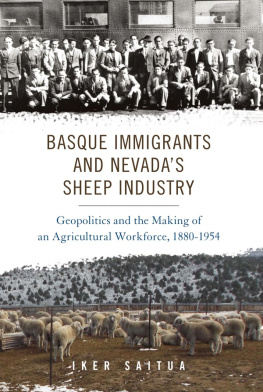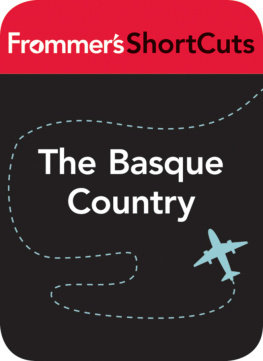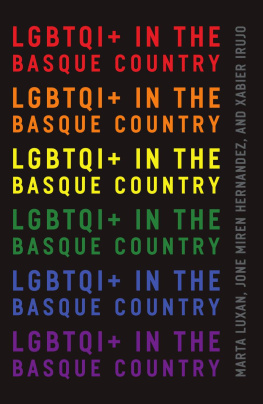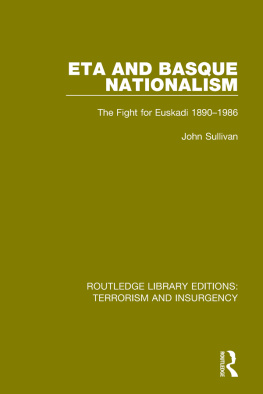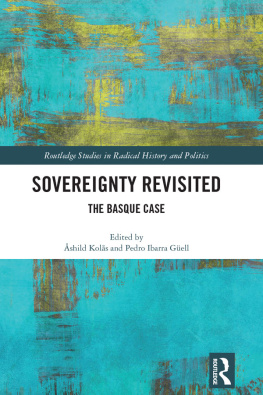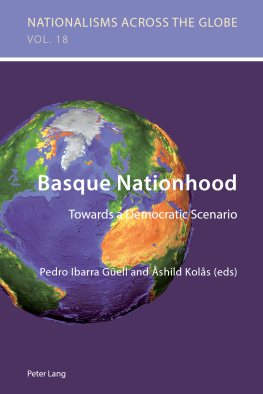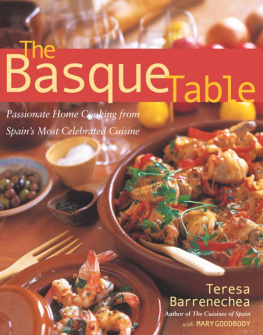The Basque Series
Basque Nationalism
by Stanley G. Payne
Amerikanuak: Basques in the New World
by William A. Douglass and Jon Bilbao
Aurrera!: A Textbook for Studying Basque
by Linda White
Back to Bizkaia: A Basque-American Memoir
by Vince J. Juaristi
The Basques, the Catalans, and Spain:
Alternative Routes to Basque Nationalization
by Daniele Conversi
Chorizos in an Iron Skillet: Memories and Recipes
from an American Basque Daughter
by Mary Ancho Davis
The Circle of Mountains: A Basque Shepherding Community
by Sandra Ott
Deep Blue Memory
by Monique Laxalt Urza
An Enduring Legacy: The Story of Basques in Idaho
by John Bieter and Mark Bieter
Gernika, 1937: The Market Day Massacre
by Xabier Irujo
The Good Oak
by Martin Etchart
Reclaiming Basque: Language, Nation, and Cultural Activism
by Jacqueline Urla
The Basque Language
by Alan R. King
Basque Firsts
by Vince J. Juaristi
Basque Immigrants and Nevadas Sheep Industry
by Iker Saitua
University of Nevada Press | Reno, Nevada 89557 USA
www.unpress.nevada.edu
Copyright 2019 by University of Nevada Press
All rights reserved
Cover design by Rebecca Lown Design
Cover photographs courtesy of Iker Saitua
LIBRARY OF CONGRESS CATALOGING-IN-PUBLICATION DATA
Names: Saitua, Iker, 1987 author.
Title: Basque immigrants and Nevadas sheep industry : geopolitics and the making of an agricultural workforce, 18801954 / Iker Saitua.
Other titles: Basque series.
Description: Reno ; Las Vegas : University of Nevada Press, [2019] | Series: Basque series | Includes bibliographical references.
Identifiers: LCCN 2018041480 (print) | LCCN 2018050926 (ebook) | ISBN 9781943859993 (pbk. : alk. paper) | ISBN 9781948908016 (cloth : alk. paper) | ISBN 9781948908023 (ebook)
Subjects: LCSH: Sheep industryNevadaHistory. | Basque AmericansNevadaHistory. | ShepherdsNevadaHistory. | SheepherdingNevadaHistory. | ImmigrantsNevadaHistory. | Sheep industryWest (U.S.)History.
Classification: LCC HD9436.U53 S25 2019 (print) | LCC HD9436.U53 (ebook) | DDC 331.6/24660979309041dc23
LC record available at https://lccn.loc.gov/2018041480
Manufactured in the United States of America
This book is dedicated
to the memory of my late grandfathers,
Manuel Saitua-Torrontegi (1922-1993)
Imanol Idarraga-Monasterio (1930-2017),
my late grandmother,
Mari Carmen Brasa-Zenikazelaia (1924-2016),
and my late great-aunt,
Sole Brasa-Zenikazelaia (1928-2017).
The four of them were members of a generation
who survived the Spanish Civil War
and its consequences in the Basque Country.
Note for Readers
Translations from sources in Basque, Spanish, and French languages including titles of secondary sources are the writers. Generally, the book presents Basque terms and names in anglicized forms, but Basque terms that have not been anglicized appear in their original spelling. The original Basque names are presented as they appear in the official documents, despite evident misspellings. It should be noted that typically Basque immigrants on their arrival in the United States anglicized their names and sometimes adopted a new one in their American integration process. Further, in the case of the Basque immigrant women, they lost their family name by marriage in the United States.
The present study considers the Basque Country as a geographical territory consisting of the following seven provinces which are divided between Spain and France. In Spain, the Basque provinces are: Biscay, Guipzcoa, lava, and Navarre. In France, the provinces are: Labourd, Lower Navarre, and Soule.
Introduction: The Basque Frontier of the American West
On June 20, 1937, the Oregonian published in its Sunday magazine a small photographic report about Basque immigrants in southeastern Oregon. The Basques were widely identified with the western open-range sheep industry, and the article explained how the Basque immigrant community was highly concentrated in both Malheur and Harney counties because their livelihoods depended on the sheep ranching economy in this corner of the Interior West. Moreover, in some places, according to the article, Basque immigrants outnumbered the native-born residents. For instance, the report estimated that in the little frontier town of Jordan Valley, Basque immigrants and their children represented about 66 percent of the total population.
The Basque were, according to this article, a friendly, hard-working race. The article continued: In northeastern Spain, from the Bay of Biscay back into the Pyrenees mountains, is the homeland of this unique race. Since prehistoric times this has been their native heath. An intensely proud and independent people, whose origin is cloaked in mystery, theirs is a race apart.
The words constituted the typically positive view of Basque immigration in the United States as the narrative had developed during previous decades when race classifications abounded. The article praised the Basque immigrants for their alleged industriousness in sheep grazing, warmhearted hospitability, and sense of pride in their origins. It also asserted that Basque immigrants assimilated easily into the dominant American culture. Although Basques were not Anglo-Saxon immigrants, the article said, they are masters of English after but few
But this accepted social status was not always the case for the Basques in the West, and their journey as an immigrant group in Americaparticularly within the western open-range sheep industry that was at the heart of Basque immigration and economic involvement from the late nineteenth century to the second half of the twentieth centurywas never a straightforward one. Indeed, the history of Basque immigrants working in the American sheep industry reveals a rich and complex story of socioeconomic integration within changing American and international political and social contexts.

Basques in the American West were associated with the open-range sheep industry from the 1880s to the 1970s. Since its beginnings, in one way or another, Basque immigrants played a noted role in the development of the commercial sheep raising in the West as a primary labor force. In the 1890s, as sheep ranching expanded rapidly in the West, the Basque Country became an important source of pliable labor to work in the public rangelands. At the turn of the century, although other ethnic groups also entered this occupation, Basques had become a noticeable and visible group in sheep grazing, particularly in Nevada, which was a nexus for Basque immigrant work in this industry. Even though Basque immigrants also worked in other industries besides sheep grazing, their work in this industry in particular shaped and strengthened the broader Basque-American communityor Amerikanuak as they were called, a corruption of the word Americans that came to refer to Basque-Americansall around the West. This historical process, which is the main subject of this study, was a complex, multidimensional, and sometimes contradictory one.
After the prominent and continuous Basque presence in the current Southwest region of the United States during the Spanish colonization, Basque immigrants began appearing in North America in considerable force around the late nineteenth century. Basque immigration to the United States is largely considered to have begun around the time of the gold rush, when a number of Basques living in Latin America migrated north to California.

